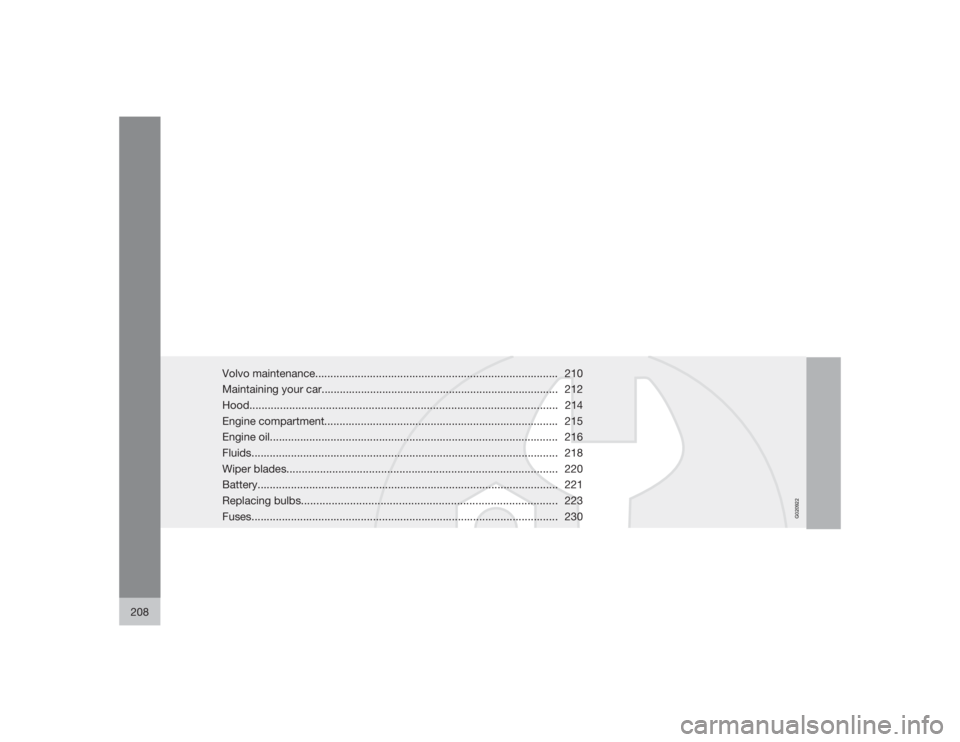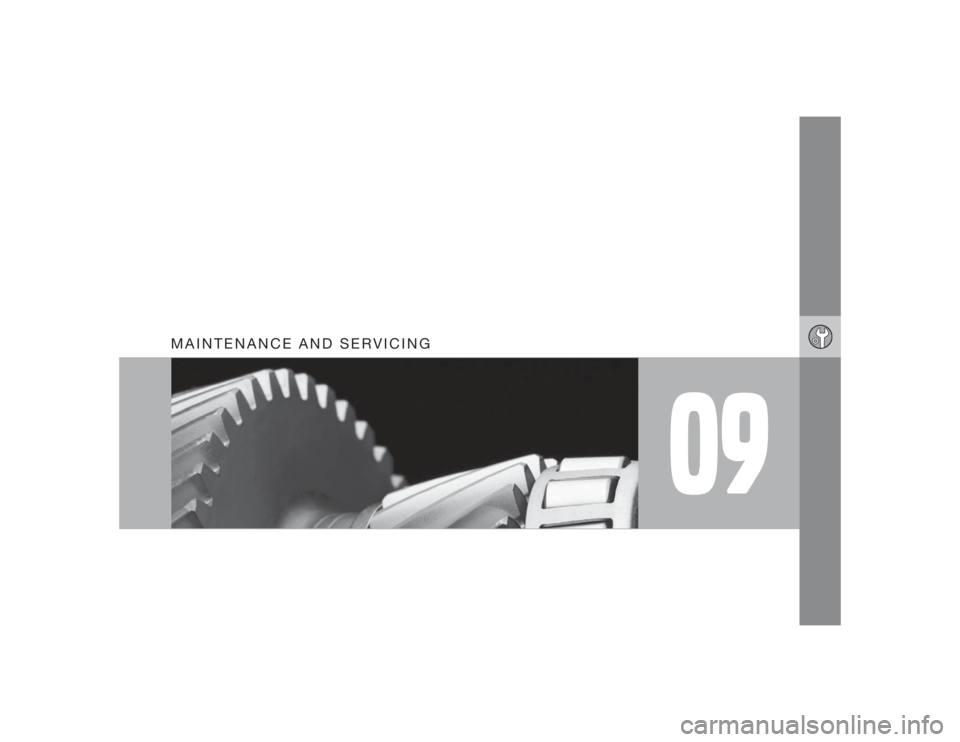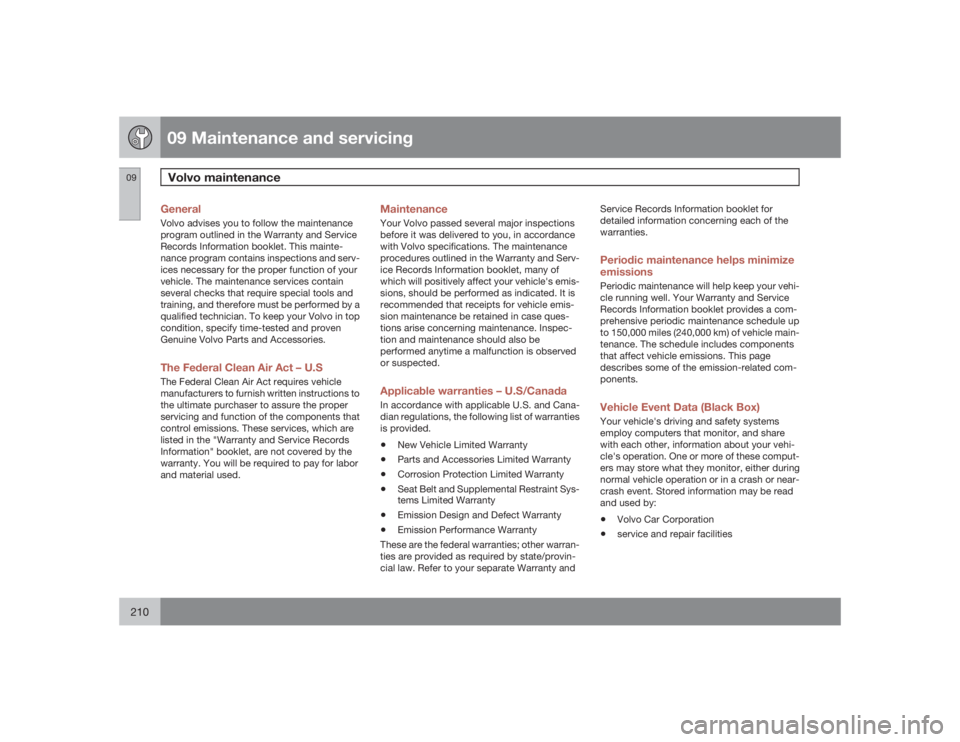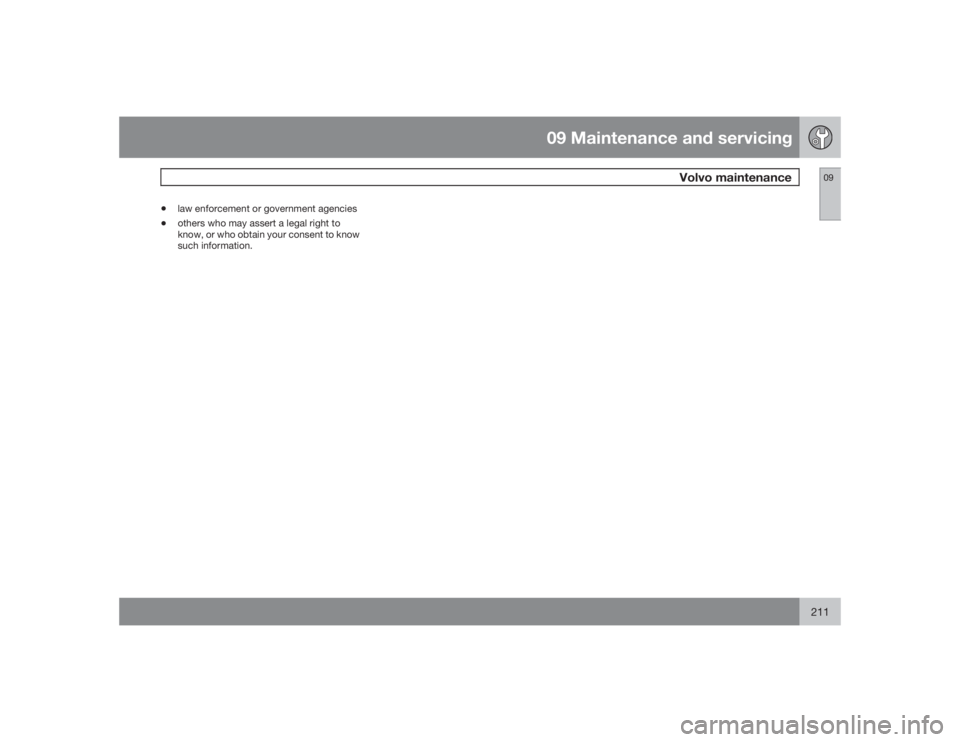2009 VOLVO S40 maintenance
[x] Cancel search: maintenancePage 160 of 286

06 Starting and drivingTowing a trailer
06160
General information•
Volvo recommends the use of Volvo trailer
hitches that are specially designed for the
vehicle.CAUTION
Models equipped with the B5244S7 engine
(engine code 39 , which is the 6th and
7th digits from the left in your vehicle's VIN
number, see page 262 for the location of
the VIN plate), may not be used to tow trail-
ers or vehicles of any kind. This could cause
damage to the vehicle's emission control
systems.Maximum trailer weights recommended by
Volvo are:•
Trailers without brakes: 1,540 lbs
(700 kg).
•
Trailers with brakes: 2,000 lbs (900 kg)
Observe the legal requirements of the
state/province in which the vehicles are
registered.
•
The maximum recommended hitch
tongue load is 165 lbs (75 kg).
•
All Volvo models are equipped with
energy-absorbing shock-mounted bump-
ers. Trailer hitch installation should not
interfere with the proper operation of this
bumper system.Trailer towing does not normally present any
particular problems, but take into considera-
tion:
•
Increase tire pressure to recommended
full. See the chapter "Wheels and tires."
•
When your vehicle is new, avoid towing
heavy trailers during the first 620 miles
(1,000 km).
•
Maximum speed when towing a trailer:
50 mph (80 km/h).
•
Engine and transmission are subject to
increased loads. Therefore, engine coolant
temperature should be closely watched
when driving in hot climates or hilly terrain.
Use a lower gear and turn off the air con-
ditioner if the temperature gauge needle
enters the red range.
•
If the automatic transmission begins to
overheat, a message will be displayed in
the information display.
•
Avoid overload and other abusive opera-
tion.
•
Hauling a trailer affects handling, durabil-
ity, and economy.
•
It is necessary to balance trailer brakes
with the towing vehicle brakes to provide a
safe stop (check and observe state/local
regulations).
•
Do not connect the trailer's brake system
directly to the vehicle's brake system.
•
More frequent vehicle maintenance is
required.
•
Remove the ball and drawbar assembly
when the hitch is not being used.
•
Volvo recommends the use of synthetic
engine oil when towing a trailer over long
distances or in mountainous areas.WARNING
•
Bumper-attached trailer hitches must
not be used on Volvos, nor should
safety chains be attached to the
bumper.
•
Trailer hitches attaching to the vehicle's
rear axle must not be used.
•
Never connect a trailer's hydraulic
brake system directly to the vehicle
brake system, nor a trailer's lighting
system directly to the vehicle lighting
system. Consult your nearest trained
and qualified Volvo service technician
for correct installation.
•
When towing a trailer, the trailer's safety
wire must be correctly fastened to the
hole or hook provided in the trailer hitch
on the vehicle. The safety wire should
never be fastened to or wound around
the drawbar ball.
Page 185 of 286

07 Wheels and tiresUniform tire quality gradings
07
185 Uniform tire quality gradings
ALL PASSENGER VEHICLE TIRES MUST
CONFORM TO FEDERAL SAFETY
REQUIREMENTS IN ADDITION TO THESE
GRADES
Quality grades can be found, where appli-
cable, on the tire sidewall between the tread
shoulder and maximum section width. For
example:
Treadwear 200 Traction AA
Temperature ATREADWEARThe treadwear grade is a comparative rating
based on the wear rate of the tire when tested
under controlled conditions on a specified gov-
ernment test course. For example, a tire gra-
ded 150 would wear one and one half (1 1/2)
times as well on the government course as a
tire graded 100. The relative performance of
tires depends upon the actual conditions of
their use, however, and many depart signifi-
cantly from the norm due to variation in driving
habits, maintenance practices and differences
in road characteristics and climate.TRACTIONThe traction grades, from highest to lowest, are
AA, A, B, and C, as measured under controlled
conditions on specified government test sur-faces of asphalt and concrete. A tire marked C
may have poor traction performance. The trac-
tion grade assigned to this tire is based on
braking (straight-ahead) traction tests and is
not a measure of cornering (turning) traction.
WARNING
The traction grade assigned to this tire is
based on braking (straight-ahead) traction
tests and is not a measure of cornering
(turning) traction.TEMPERATUREThe temperature grades are AA (the highest),
A, B, and C, representing the tire's resistance
to the generation of heat and its ability to dis-
sipate heat when tested under controlled con-
ditions on a specified indoor laboratory test
wheel. Sustained high temperature can cause
the material of the tire to degenerate and
reduce tire life, and excessive temperature can
lead to sudden tire failure. The grade C corre-
sponds to a minimum level of performance that
all passenger vehicle tires must meet under the
Federal Motor Safety Standard No. 109.
Grades B and A represent higher levels of per-
formance on the laboratory test wheel than the
minimum required by law.
WARNING
The temperature grade for this tire is estab-
lished for a tire that is properly inflated and
not overloaded. Excessive speed, under-
inflation, or excessive loading, either sepa-
rately or in combination, can cause heat
buildup and tire failure.
Page 189 of 286

07 Wheels and tires
Tire rotation
07
189
G020325
The arrows shows the direction of rotation of the
tireSummer and winter tires•
When switching between summer and
winter tires, mark the tires to indicate
where they were mounted on the car, e.g.,
LF = left front, RR = right rear
•
Tires with tread designed to roll in only one
direction are marked with an arrow on the
sidewall.
•
Incorrectly mounted tires impair the car's
braking properties and ability to force
aside rain, snow and slush.
•
The tires with the most tread should always
be at the rear (to reduce the risk of skid-
ding).
•
Contact a Volvo workshop if you are
unsure about the tread depth.
Tire rotationYour vehicle has no recommended tire rota-
tion. The following information is intended to
help you understand why.Tread setAs a tire ages and the rubber cures, front and
rear tires set at different angles. Therefore, if
tires are rotated, the tread will eventually set at
an angle that is a compromise. Even if ride,
handling, and road noise may still seem
acceptable, they may not be optimal. Further,
tires that are rotated, but not on a regular basis,
may actually cause more tire noise, faster tire
wear, and unpleasant changes in steering feel
and vehicle handling.
A tire that can fully adapt to its position will
provide better steering feel, lower tire noise,
and better fuel economy.Braking stability performanceYour vehicle is driven mainly by the front tires,
which will wear faster. This can be beneficial.
Having more tread on the rear tires will help
reduce oversteer. Oversteer is when a vehicle
wants to keep turning because of momentum
and dynamic forces on its suspension.Suspension wear diagnosticsEvery suspension needs periodic inspection
and maintenance. A tire's wear pattern can bean aid in detecting a suspension problem. Each
tire, if left in place, tells a story about the sus-
pension. Tire rotation, on the other hand, could
make suspension wear harder to detect. Early
detection is very important, because suspen-
sion problems can make tire wear worse.
If you do rotate your tires…Please follow the tire manufacturer's recom-
mendations, as outlined in the tire manufactur-
ers tire warranty pamphlet.
Your Volvo retailer can also provide guidance
based on your particular driving circumstan-
ces.
Page 197 of 286

07 Wheels and tires
Tire Pressure Monitoring System (TPMS)
07�`�`197 Introduction
The tire pressure monitoring system uses sen-
sors mounted in the tire valves to check infla-
tion pressure levels. When the vehicle is
moving at a speed of approximately 20 mph
(30 km/h) or faster, these sensors transmit
inflation pressure data to a receiver located in
the vehicle.
NOTE
USA – FCC ID: KR5S122780002
This device complies with part 15 of the
FCC rules. Operation is subject to the fol-
lowing conditions: (1) This device may not
cause harmful interference, and (2) this
device must accept any interference
received, including interference that may
cause undesired operation.When low inflation pressure is detected, TPMS
will light up the tire pressure warning light (also
referred to as a telltale) in the instrument panel,
and will display a message in the text window.
The wording of this message is determined by
the degree of inflation pressure loss.
NOTE
If a fault occurs in TPMS, the tire pressure
warning light will flash for approximately
1 minute and
TIRE PRESS SYST
SERVICE REQUIRED
will be displayed.
Each tire, including the spare (if provided),
should be checked monthly when cold and
inflated to the inflation pressure recommended
by the vehicle manufacturer on the vehicle
placard or tire inflation pressure label. (If your
vehicle has tires of a different size than the size
indicated on the vehicle placard or tire inflation
pressure label, you should determine the
proper tire inflation pressure for those tires.)
As an added safety feature, your vehicle has
been equipped with a tire pressure monitoring
system (TPMS) that illuminates a low tire pres-
sure telltale when one or more of your tires is
significantly under-inflated. Accordingly, when
the low tire pressure telltale illuminates, you
should stop and check your tires as soon as
possible, and inflate them to the proper pres-
sure. Driving on a significantly under-inflated
tire causes the tire to overheat and can lead to
tire failure. Under-inflation also reduces fuel
efficiency and tire tread life, and may affect the
vehicle's handling and stopping ability.
Please note that the TPMS is not a substitute
for proper tire maintenance, and it is the driv-er's responsibility to maintain correct tire pres-
sure, even if under-inflation has not reached
the level to trigger illumination of the TPMS low
tire pressure telltale.
Your vehicle has also been equipped with a
TPMS malfunction indicator to indicate when
the system is not operating properly. The
TPMS malfunction indicator is combined with
the low tire pressure telltale. When the system
detects a malfunction, the telltale will flash for
approximately one minute and then remain
continuously illuminated. This sequence will
continue upon subsequent vehicle start-ups as
long as the malfunction exists. When the mal-
function indicator is illuminated, the system
may not be able to detect or signal low tire
pressure as intended. TPMS malfunctions may
occur for a variety of reasons, including the
installation of replacement or alternate tires or
wheels on the vehicle that prevent the TPMS
from functioning properly. Always check the
TPMS malfunction telltale after replacing one
or more tires or wheels on your vehicle to
ensure that the replacement or alternate tires
and wheels allow the TPMS to continue to
function properly.
Page 208 of 286

G020922
208
Volvo maintenance................................................................................ 210
Maintaining your car.............................................................................. 212
Hood.....................................................................................................214
Engine compartment............................................................................. 215
Engine oil............................................................................................... 216
Fluids..................................................................................................... 218
Wiper blades......................................................................................... 220
Battery................................................................................................... 221
Replacing bulbs.................................................................................... 223
Fuses..................................................................................................... 230
Page 209 of 286

09
MAINTENANCE AND SERVICING
Page 210 of 286

09 Maintenance and servicingVolvo maintenance
09210
GeneralVolvo advises you to follow the maintenance
program outlined in the Warranty and Service
Records Information booklet. This mainte-
nance program contains inspections and serv-
ices necessary for the proper function of your
vehicle. The maintenance services contain
several checks that require special tools and
training, and therefore must be performed by a
qualified technician. To keep your Volvo in top
condition, specify time-tested and proven
Genuine Volvo Parts and Accessories.The Federal Clean Air Act – U.SThe Federal Clean Air Act requires vehicle
manufacturers to furnish written instructions to
the ultimate purchaser to assure the proper
servicing and function of the components that
control emissions. These services, which are
listed in the "Warranty and Service Records
Information" booklet, are not covered by the
warranty. You will be required to pay for labor
and material used.
MaintenanceYour Volvo passed several major inspections
before it was delivered to you, in accordance
with Volvo specifications. The maintenance
procedures outlined in the Warranty and Serv-
ice Records Information booklet, many of
which will positively affect your vehicle's emis-
sions, should be performed as indicated. It is
recommended that receipts for vehicle emis-
sion maintenance be retained in case ques-
tions arise concerning maintenance. Inspec-
tion and maintenance should also be
performed anytime a malfunction is observed
or suspected.Applicable warranties – U.S/CanadaIn accordance with applicable U.S. and Cana-
dian regulations, the following list of warranties
is provided.•
New Vehicle Limited Warranty
•
Parts and Accessories Limited Warranty
•
Corrosion Protection Limited Warranty
•
Seat Belt and Supplemental Restraint Sys-
tems Limited Warranty
•
Emission Design and Defect Warranty
•
Emission Performance Warranty
These are the federal warranties; other warran-
ties are provided as required by state/provin-
cial law. Refer to your separate Warranty andService Records Information booklet for
detailed information concerning each of the
warranties.
Periodic maintenance helps minimize
emissionsPeriodic maintenance will help keep your vehi-
cle running well. Your Warranty and Service
Records Information booklet provides a com-
prehensive periodic maintenance schedule up
to 150,000 miles (240,000 km) of vehicle main-
tenance. The schedule includes components
that affect vehicle emissions. This page
describes some of the emission-related com-
ponents.Vehicle Event Data (Black Box)Your vehicle's driving and safety systems
employ computers that monitor, and share
with each other, information about your vehi-
cle's operation. One or more of these comput-
ers may store what they monitor, either during
normal vehicle operation or in a crash or near-
crash event. Stored information may be read
and used by:•
Volvo Car Corporation
•
service and repair facilities
Page 211 of 286

09 Maintenance and servicing
Volvo maintenance
09
211
•
law enforcement or government agencies
•
others who may assert a legal right to
know, or who obtain your consent to know
such information.